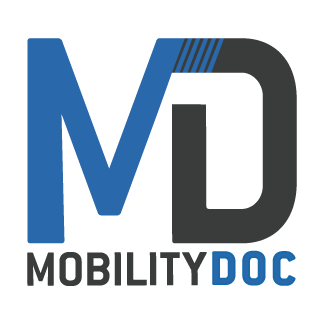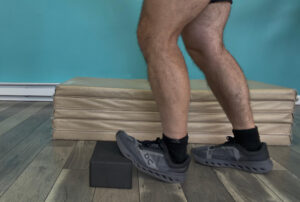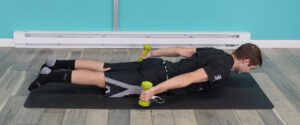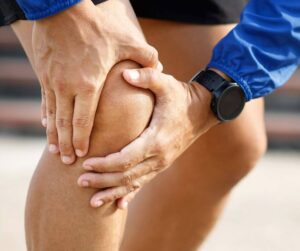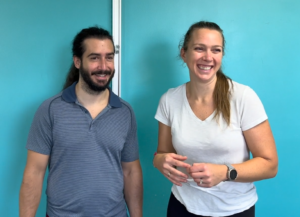Achilles tendinitis can be a frustrating and painful condition, often resulting from overuse or excessive strain on the Achilles tendon. This thick band of tissue connects your calf muscles to your heel bone, allowing for essential movements like walking, running, and jumping. When this tendon becomes inflamed, it leads to discomfort and impacts your ability to live your active lifestyle. Fortunately, we have some great self-treatment methods you can use to alleviate pain and promote healing. Here are six effective achilles tendinitis self-care methods to help you get past this achilles pain.
Why Does My Achilles Hurt?
As we get into the recovery methods you’ll notice we’re doing a lot of work to the calf. That’s because the achilles attaches into the calf muscle (gastroc) and anchors into the heel bone. When your calf gets really tight it begins to pull on the tendon. It keeps pulling and pulling until it can’t anymore. When the tension builds enough that tendon starts becoming inflamed and painful. If you don’t act to relieve that tension and pulling it can lead to a partial tear or full rupture of the achilles tendon. We’re excited that you’re here so it doesn’t have to get to that!
6 Achilles Tendinitis Self-Care Methods
These methods are being introduced in the order they should be used! If you don’t have all of these tools, no problem. Do what you can and you’ll still receive benefits!
1. Warm Up

Like most things, it’s important to prepare the area by warming up. You can do this by walking or jogging however sometimes this can be painful. If it’s too irritated and uncomfortable, start your self-treatment by using a massage gun on the affected area.
This tool increases blood flow to the Achilles tendon and surrounding muscles, preparing them for the work ahead. Focus on the calf muscles and the tendon itself, spending about 2-3 minutes on the area. The vibration helps to reduce tension, enhance circulation, and can provide immediate pain relief. Be careful not to go directly onto the hot spot! This can can lead to more irritation.
2. Foam Rolling

Next, grab your foam roller. Foam rolling complements the massage gun by continuing to warm up the area while breaking up adhesions and scar tissue. Spend 1-2 minutes scanning the calves and the lower leg. Just like the massage gun, make sure to avoid going directly on the pain point. After scanning the area for a full minute, if you find any hard or painful spots you can hold on them for 30 seconds or so. This technique can help release knots and improve flexibility.
3. Muscle Flossing

Dr. John is demonstrating 2 places to use muscle floss for achilles tendinitis self-care. In the photo above the calf is being flossed. To the right the achilles and base of the calf are being flossed

One of our favorite achilles tendinitis self-care methods is Muscle flossing. This involves wrapping a muscle floss band around your calf and/or achilles. While it’s wrapped perform dynamic movements to break up scar tissue and improve blood flow. Start by wrapping the band around your calf, ensuring it’s snug (about 70% tension). Move through a range of motion—such as ankle flexion and extension or toe raises—for 60-90 seconds. This technique allows you to “floss” the muscle, promoting circulation while effectively breaking up any adhesions in the tendon. Pro Tip: Always re-wrap the band before starting a new section!
4. Muscle Scraping
Instrument assisted soft tissue mobilization can further enhance blood flow and reduce inflammation. Using medium pressure and moving in 2 inch sections, scrape the tool along the tendon and surrounding muscles for about 2 minutes. This technique not only helps with circulation but also encourages the healing process by breaking down scar tissue.

Be mindful of your pressure—start light and gradually increase as tolerated. It’s really important to muscle scrape the entire calf for the most benefit!
5. Dynamically Stretching the Area

Since we’re looking to stretch the whole tendon, from the heel to the calf, it’s important to elevate your toes. You can use a weight, yoga block, or step to lift your toes. This will stretch your calves and tendon to enhance flexibility and relieve tension.
We are getting our knee over our toes while bringing our chest forward over the elevated toes. Now straighten and bend your knee to dynamically stretch all the way through the back of the leg. Repeat this for 2-3 sets. This will help lengthen the Achilles tendon and calf muscles, alleviating some discomfort.
6. Negative Calf Raises
Finally, focus on negative calf raises. You can do this on the floor or on a step. Elevate yourself into a heel raise, then shift your weight over to your problem foot. Slowly lower your heels down relying on the “good” leg to stabilize and take pressure as needed. This exercise emphasizes the lowering phase, which is crucial for strengthening the tendon and teaching it to handle loads properly. Aim for 2-3 sets of 10 repetitions. If this is the beginning stages of recovery proceed slowly and incorporate more as your body allows it. Make sure you’re maintaining control throughout the movement.

Watch This Video On How To Do These 6 Achilles Tendinitis Self-Care Methods
Putting It All Together
Incorporating these six self-treatment methods into your routine takes about 20 minutes and significantly aid in your recovery from Achilles tendinitis. Not only will you alleviate pain and tension, but you’ll also promote healing and improve your range of motion. Remember, consistency is key—integrate these techniques into your daily regimen, and listen to your body as you heal. If your pain persists, consult a healthcare professional for further evaluation and guidance. Your Achilles tendon will thank you!
This blog contains affiliate links to Sidekick Muscle Scraping tools
Unlock Your Body’s Potential with MDRx: Full Body Mobility Program!
Are you feeling stiff, restricted, or limited in your movement? Our Full Body Mobility Program is designed to help you break free and move with ease!
This comprehensive program focuses on improving flexibility, range of motion, and overall stability through your entire body. We target the main areas including back, shoulders, hips, and ankles. The best part is each day offers bite sized mobility work so it can fit anywhere into your day!
Join our MDRx: Full Body Mobility Program today and discover the freedom of effortless movement! Don’t let stiffness hold you back—take the first step toward a more mobile, active life!
Is Your Achilles Rupture The End Of Your Athletic Career?
Read about what it means here
